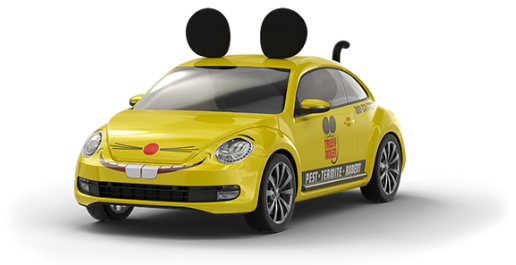
Bee Facts
- Location: With the exception of Antarctica, bees are found throughout the world, in every habitat on the planet that contains insect-pollinated flowering plants
- Size: Bees range in size from tiny species – only 2 mm in length – to rather large insects – up to 4 cm long
- Color: Many bees are black, brown, or gray, but others are bright yellow, red, or metallic green or blue
- Appearance: Flat bodies and six legs
Bee Behavior
“Bee” is the common name for a winged, flower-feeding insect with branched body hairs. Bees are dependent on pollen as a protein source and on flower nectar or oils as an energy source. There are about 20,000 different species of bees in the world. T
Although bees may be solitary, many live in various types of communities. Bees most commonly live in colonies with three different types of bees in each colony – the queen bee, the infertile worker bee (female), and the drone (male). Only the queen bee can reproduce. The drone’s only job is to mate with the queen and die soon after having fulfilled their task. The queen’s only job is to lay eggs for the span of her life. The worker bees perform many jobs necessary for the survival of the hive. They clean the hive, collect pollen and nectar to feed the colony, and they take care of the offspring. Honey bee queens can live up to five years, though most average a lifespan of two to three years. By contrast, the average life span of a female worker bee is usually only six weeks.
Bees have five eyes — two large compound eyes and three simple eyes and can see all colors except the color red. Their vision and their sense of smell help them find the flowers they need to collect pollen. Pollen is an important food source for bees. Most bees have specialized feathery body hairs that help in the collection of pollen. Adult worker bees collect pollen as sustenance for both adult and larval bees — it contains protein and other nutrients necessary to their survival. While foraging for nectar and pollen, bees inadvertently transfer pollen from the male to the female components of flowers. The pollen they inevitably lose as they fly from flower to flower is important to plants because some pollen lands on the reproductive structures of other flowers of the same species, resulting in cross-pollination.
Bees are the most important pollinating insects, and their interdependence with plants makes them an excellent example of symbiosis that is beneficial to both parties. Bees are environmentally friendly and are vital as pollinators. Each year, bees pollinate an estimated $10 billion of crops in the United States alone. And some estimate that these insect pollinators contribute to one-third of the world’s diet. Some bees produce honey from flower nectar. Bees possess an organ that converts nectar into honey, which is collected, depending on the species, inside the hive or bee colony. Beekeepers use smoke to calm bees when they are collecting honey or relocating a hive.
Bee Nests
Different bee and wasp species have different nesting behaviors so it is important to have a positive identification before beginning treatment. Yellow jackets, hornets and paper wasps make nests of paper. Honey bees and bumblebees make nests of wax. Solitary bees and wasps nest in holes in the ground, rotten wood or natural cavities. Some wasps even make mud nests.
Bee Swarming
When bees swarm, it’s so their colony can spread out into new areas. An old queen bee leaves an overcrowded colony with hundreds of existing worker bees to establish a new colony. They look for a new place to live by first traveling away from the original colony. Then, scout bees are sent out to look for an acceptable location to begin a new colony. The scout bees identify a new site and then return to the swarm to bring it to the new location. In transition, the swarm hangs together in a large mass and may land on a tree branch or other surface to rest. The swarm generally remains for less than a day and then it moves on to the new location.
- Stings and Treatment
- How to get rid of Bees
- Bee Infestation
4 Seasons Pest Control

Satisfaction Guarantee
What it includes*
-
Ants
-
Crickets
-
Fleas
-
Mice
-
All Roaches
-
Scorpions
-
Spiders
-
Ticks
-
Wasps
-
Other*
